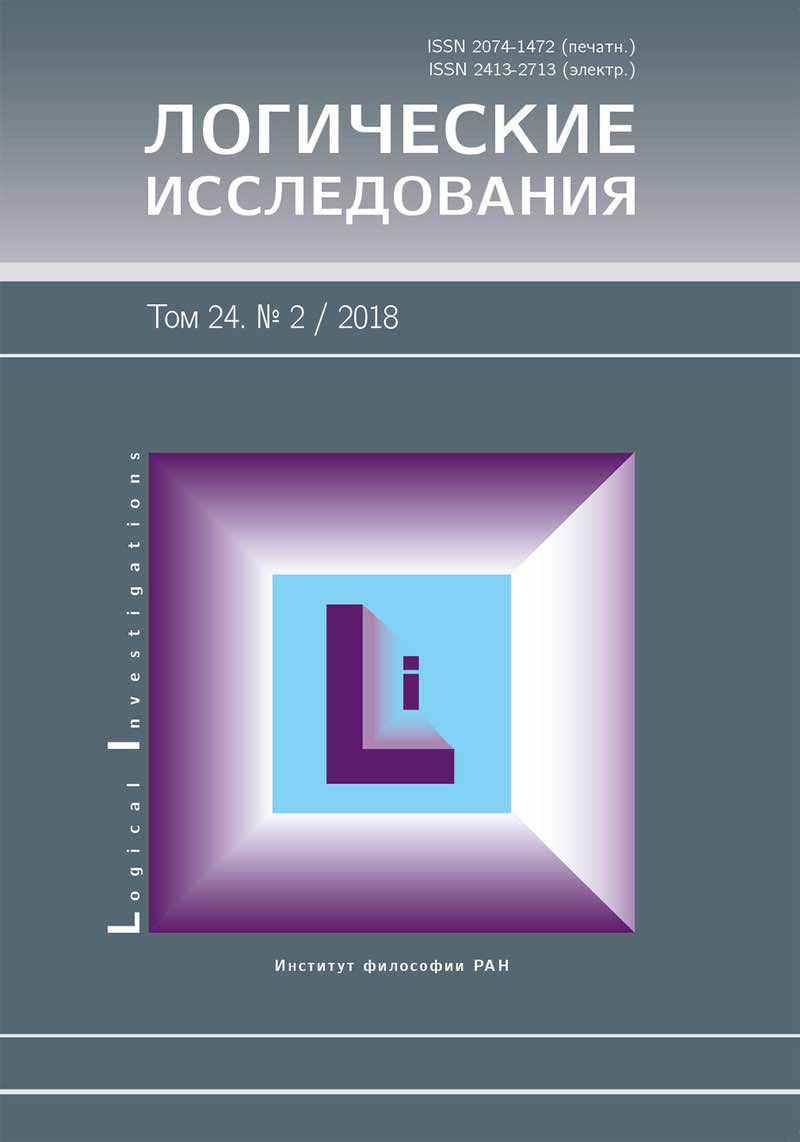On a continual class of four-valued maximally paranormal logics
Main Article Content
Abstract
The problem of contradictory or incomplete information has an important place in modern philosophical logic. The methods of many-valued logic have been widely applied in this field. One promising direction is the study of four-valued logics, which facilitate working with contradictory as well as incomplete information simultaneously. This work lies within this approach.
This paper is devoted to a set of continuum cardinality consisting of maximum strong four-valued paranormal logics. I describe the four-valued matrix that induces the logic $\mathbf{I}^{1}\mathbf{P}^1$ and demonstrate that, although it is neither maximally paraconsistent nor maximally paracomplete in the strong sense, there are continuum-many of its four-valued linguistic extensions that possess such properties.
The solution to the problem is structured as follows. First, I construct the four-valued matrices for the logics $\mathbf{P}^1$ and $\mathbf{I}^1$. It turns out that the matrix of $\mathbf{I}^{1}\mathbf{P}^1$ constitutes a functional extension of the former as well as the latter. This entails that $\mathbf{I}^{1}\mathbf{P}^1$ is a linguistic variant of a common linguistic extension of $\mathbf{P}^1$ and $\mathbf{I}^1$. It is known that $\mathbf{P}^1$ and all of its linguistic extensions are maximally paraconsistent in the strong sense. Since $\mathbf{I}^1$ is the dual of $\mathbf{P}^1$, it and all of its linguistic extensions are maximally paracomplete in the strong sense. However, while $\mathbf{P}^1$ and $\mathbf{I}^1$ are embeddable into $\mathbf{I}^{1}\mathbf{P}^1$, it is not the case that it is maximally paraconsistent or maximally paracomplete. At the same time, some of its linguistic extensions do have such properties.
Further, the lower boundary of the total amount of linguistic extensions of $\mathbf{I}^{1}\mathbf{P}^1$ of the relevant type is established. For this I show that the set of all operations definable in the matrix of $\mathbf{I}^{1}\mathbf{P}^1$ supplemented with the operators $\bot_{f}$ and $\top_{t}$ has continuum-many pairwise distinct closed supersets. The closed class $F$ of functions of four-valued logic with the countable basis is constructed. Such a class contains continuum-many pairwise distinct subclasses. Finally, it is demonstrated that no two subclasses of $F$ supplemented with operations of the matrix of $\mathbf{I}^{1}\mathbf{P}^1$, $\bot_{f}$ and $\top_{t}$ will be equivalent upon closure with respect to superposition. DOI: 10.21146/2074-1472-2018-24-2-85-91
This paper is devoted to a set of continuum cardinality consisting of maximum strong four-valued paranormal logics. I describe the four-valued matrix that induces the logic $\mathbf{I}^{1}\mathbf{P}^1$ and demonstrate that, although it is neither maximally paraconsistent nor maximally paracomplete in the strong sense, there are continuum-many of its four-valued linguistic extensions that possess such properties.
The solution to the problem is structured as follows. First, I construct the four-valued matrices for the logics $\mathbf{P}^1$ and $\mathbf{I}^1$. It turns out that the matrix of $\mathbf{I}^{1}\mathbf{P}^1$ constitutes a functional extension of the former as well as the latter. This entails that $\mathbf{I}^{1}\mathbf{P}^1$ is a linguistic variant of a common linguistic extension of $\mathbf{P}^1$ and $\mathbf{I}^1$. It is known that $\mathbf{P}^1$ and all of its linguistic extensions are maximally paraconsistent in the strong sense. Since $\mathbf{I}^1$ is the dual of $\mathbf{P}^1$, it and all of its linguistic extensions are maximally paracomplete in the strong sense. However, while $\mathbf{P}^1$ and $\mathbf{I}^1$ are embeddable into $\mathbf{I}^{1}\mathbf{P}^1$, it is not the case that it is maximally paraconsistent or maximally paracomplete. At the same time, some of its linguistic extensions do have such properties.
Further, the lower boundary of the total amount of linguistic extensions of $\mathbf{I}^{1}\mathbf{P}^1$ of the relevant type is established. For this I show that the set of all operations definable in the matrix of $\mathbf{I}^{1}\mathbf{P}^1$ supplemented with the operators $\bot_{f}$ and $\top_{t}$ has continuum-many pairwise distinct closed supersets. The closed class $F$ of functions of four-valued logic with the countable basis is constructed. Such a class contains continuum-many pairwise distinct subclasses. Finally, it is demonstrated that no two subclasses of $F$ supplemented with operations of the matrix of $\mathbf{I}^{1}\mathbf{P}^1$, $\bot_{f}$ and $\top_{t}$ will be equivalent upon closure with respect to superposition. DOI: 10.21146/2074-1472-2018-24-2-85-91
Downloads
Download data is not yet available.
Article Details
How to Cite
Devyatkin L. Y. On a continual class of four-valued maximally paranormal logics // Logicheskie Issledovaniya / Logical Investigations. 2018. VOL. 24. № 2. C. 85-91.
Issue
Section
Papers
References
Карпенко А.С., Томова Н.Е. Трехзначная логика Бочвара и литеральные паралогики. М.: ИФ РАН, 2016. 110 с.
Arieli O., Avron A. Four-Valued Paradefinite Logics // Studia Logica. 2017. Vol. 105. No 6. P. 1087–1122.
Arieli O., Avron A., Zamansky A. Maximal and Premaximal Paraconsistency in the Framework of Three-Valued Semantics // Studia Logica. 2011. Vol. 97. No. 1. P. 31–60.
Brunner A.B., Carnielli W.A. Anti-Intuitionism and Paraconsistency // Journal of Applied Logic. 2005. Vol. 3. No. 1. P. 161–184.
Fernandez V.L. Semantica de Sociedades para Logicas n-valentes. Campinas: IFCH-UNICAMP. 2001. 126 p.
Lau D. Function Algebras on Finite Sets: Basic Course on Many-Valued Logic and Clone Theory. Berlin; Heidelberg; N. Y.: Springer. 2006. 670 p.
Wojtylak P. Mutual interpretability of sentential logic I // Reports on Mathematicl Logic. 1981. Vol. 11. P. 69–89.
Wojcicki R. Theory of Logical Calculi: Basic Theory of Consequence Operations. Dordrecht: Kluwer, 1988. 474 p.
Arieli O., Avron A. Four-Valued Paradefinite Logics // Studia Logica. 2017. Vol. 105. No 6. P. 1087–1122.
Arieli O., Avron A., Zamansky A. Maximal and Premaximal Paraconsistency in the Framework of Three-Valued Semantics // Studia Logica. 2011. Vol. 97. No. 1. P. 31–60.
Brunner A.B., Carnielli W.A. Anti-Intuitionism and Paraconsistency // Journal of Applied Logic. 2005. Vol. 3. No. 1. P. 161–184.
Fernandez V.L. Semantica de Sociedades para Logicas n-valentes. Campinas: IFCH-UNICAMP. 2001. 126 p.
Lau D. Function Algebras on Finite Sets: Basic Course on Many-Valued Logic and Clone Theory. Berlin; Heidelberg; N. Y.: Springer. 2006. 670 p.
Wojtylak P. Mutual interpretability of sentential logic I // Reports on Mathematicl Logic. 1981. Vol. 11. P. 69–89.
Wojcicki R. Theory of Logical Calculi: Basic Theory of Consequence Operations. Dordrecht: Kluwer, 1988. 474 p.
